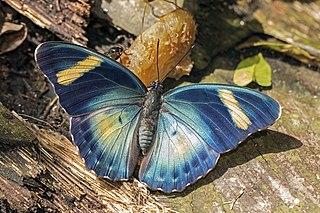
Mosquitoes are members of a group of almost 3,600 species of small flies within the family Culicidae. The word "mosquito" is Spanish for "little fly". Mosquitoes have a slender segmented body, one pair of wings, one pair of halteres, three pairs of long hair-like legs, and elongated mouthparts.

Aedes albopictus, from the mosquito (Culicidae) family, also known as the (Asian) tiger mosquito or forest mosquito, is a mosquito native to the tropical and subtropical areas of Southeast Asia. In the past few centuries, however, this species has spread to many countries through the transport of goods and international travel. It is characterized by the white bands on its legs and body.

Toxorhynchites, also called elephant mosquito or mosquito eater, is a genus of diurnal and often relatively colorful mosquitoes, found worldwide between about 35° north and 35° south. Most species occur in forests. It includes the largest known species of mosquito, at up to 18 mm (0.71 in) in length and 24 mm (0.94 in) in wingspan. It is among the many kinds of mosquito that do not consume blood. The adults subsist on carbohydrate-rich materials, such as honeydew, or saps and juices from damaged plants, refuse, fruit, and nectar.
Stegomyia is a large subgenus of the mosquito genus Aedes with 131 species classified in six species groups, two groups of which are further divided into subgroups.

The Prêmio Machado de Assis is a literary prize awarded by the Brazilian Academy of Letters, and possibly the most prestigious literary award in Brazil. The prize was founded in 1941, named in memory of the novelist Joaquim Maria Machado de Assis (1839–1908). It is awarded in recognition of a lifetime's work.

Ochlerotatus is a genus of mosquito. Until 2000, it was ranked as a subgenus of Aedes, but after Reinert's work, the clade was upgraded to the level of a genus. This change has resulted in the renaming of many subgenus species, and many aedini-related taxa are undergoing taxonomic revisions. Some authors are still using traditional taxonomic names in their publications.

Anopheles is a genus of mosquitoes (Culicidae). Of about 484 recognised species, over 100 can transmit human malaria, but only 30–40 commonly transmit parasites of the genus Plasmodium that cause malaria, which affects humans in endemic areas. Anopheles gambiae is one of the best known, because of its predominant role in the transmission of the deadly species Plasmodium falciparum.

Aedes pembaensis is a mosquito.

Euphaedra is a butterfly genus in the subfamily Limenitidinae. The species are confined to the Afrotropical realm mainly in the Guinean Forests of West Africa and the Congolian forests.
Uranotaenia is a subgenus of the mosquito genus Uranotaenia with 121 species:
The Afrotropical mosquito genus Eretmapodites contains species that exhibit facultative cannibalism in their larval developmental stages. The species was first described in 1901 by Frederick Vincent Theobald. The type species is Eretmapodites quinquevittatus Theobald
Orthopodomyia is a genus of mosquitoes in the family Culicidae. There are at least 40 described species in Orthopodomyia.
Aedeomyia is a genus of flies belonging to the family Culicidae.
Armigeres is a genus of mosquito belonging to the family Culicidae.







